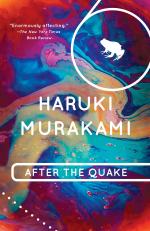|
This section contains 1,275 words (approx. 4 pages at 400 words per page) |

|
Point of View
By nature, After the Quake features shifting points of view; each story has a different protagonist, and the stories are not explicitly related to one another. This shifting of focus allows Murakami to draw connections between the stories without having to outline them overtly. In a setting where the characters were consistent, they might themselves be able to draw these connections; the relationship between Yoshiya's self-confident persona being called "Super-Frog" and the manifestation of an actual Super-Frog in "Super-Frog Saves Tokyo," for instance, is allowed to remain subtle and understated. In a sense, this lack of explicit acknowledgement imbues the collection with more gestural power, threading the stories together by their emotional beats and fables rather than their plots.
Though each story surely features a character whose perspective the narration is attached to (Komura, Junko, Yoshiya, Satsuki, Katagiri, and Junpei), none of the stories is...
|
This section contains 1,275 words (approx. 4 pages at 400 words per page) |

|




